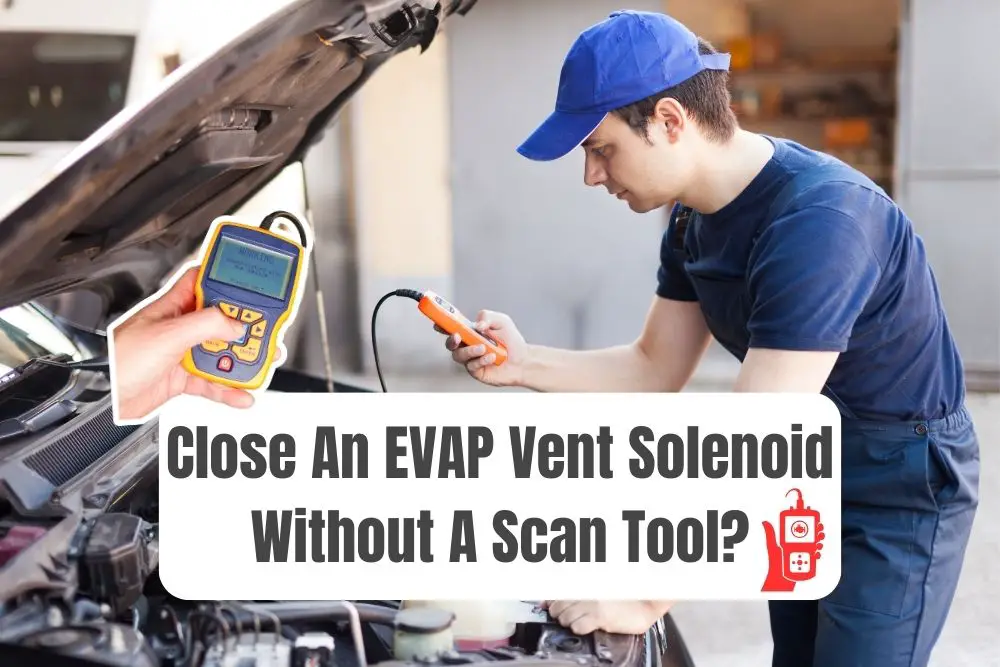When diagnosing the EVAP system, or if you need to perform an EVAP leak test, it might prove beneficial to close the EVAP vent solenoid first. But, how to close the EVAP vent solenoid without using a scan tool?
There are times when an OBD diagnostics scan tool might not be readily available, or if your scan tool does not feature the right controls for closing the EVAP vent solenoid. Thankfully, there are some alternatives.
While it may not be as straightforward, you can manually close the EVAP vent solenoid using jumper wires, or a vacuum pump, by applying battery voltage, or manually activating the EVAP vent solenoid.
So, here’s a quick look at 4 techniques and alternatives…
Method #1: Using A Jumper Wire
When it comes to EVAP vent solenoid diagnosis and testing, an advanced OBD scan tool with bi-directional control is used for this purpose. However, not everyone might have access to these tools due to their cost.
One effective method to closing an EVAP vent solenoid without a scan tool is using a set of jumper wires to manually activate the solenoid. This can be done at the PCM (Powertrain Control Module) connector.
Or, you could also do this directly at the vent solenoid if it’s accessible. It’s crucial to determine whether the solenoid is power or ground-side controlled. Remember, the valve is usually open when the engine is off.
Moreover, it’s only closed by the PCM during testing. Caution is advised here; if you’re not confident in your skills, it might be best to seek professional help. Always use a fused jumper wire for extra safety, too.
Method #2: Manually Activating The Solenoid
Some cars allow for manual activation of the EVAP vent solenoid. This involves physically manipulating the solenoid or its control mechanism. For instance, certain cars may have a lever or button on the solenoid.
This button can be pressed or moved to close the valve. This method requires a good understanding of your car’s specific EVAP system layout and should be approached with caution to avoid damaging the solenoid.
CAUTION: It’s important to note that manually closing your EVAP vent solenoid and conducting smoke tests without proper closure involves risks of damaging the EVAP system. Incorrect handling could lead to further damage to your EVAP system or other vehicle components. Always prioritize safety and, if in doubt, consult with a professional mechanic.
Method #3: Applying Some Battery Voltage
In some cases, you can alternatively close your EVAP vent solenoid by applying battery voltage directly to it. This method requires identifying the correct terminals on the solenoid and applying some voltage to it.
You could use wires connected to your car’s 12V battery. It’s important to ensure that the polarity is correct to prevent damage. A multimeter is helpful in identifying the correct terminals and the proper voltage.
Remember, while these DIY methods do work, they come with their own set of risks. Always weigh the pros and cons and consider your level of expertise before attempting any of these repairs or modifications.
CAUTION: While exploring these methods, safety should always be your top priority. Incorrect handling can lead to damage to the EVAP system or other vehicle components. If you’re unsure about any procedure, it’s advisable to consult the vehicle’s service manual or seek professional assistance.
Method #4: Using A Vacuum Pump
For mechanically operated vent solenoids, using a handheld vacuum pump can be an effective way to close the valve. By applying a vacuum to the correct port on the solenoid, you can manually close the valve.
This method is far less common but can be applicable in older vehicles or specific models with mechanically controlled EVAP systems. But, remember to approach this with caution to prevent causing more damage.
For more insights into how EVAP systems work, it practically captures excess fuel vapors from a car’s fuel tank and temporarily stores them in the charcoal canister. It’s basically an emissions control system.
When your engine runs, these vapors are purged and burned in the combustion process. A key component of this system is the vent solenoid, which controls the release of these vapors by opening and closing.
Do You Need To Actually Close The EVAP Vent Solenoid
However, you might be wondering… What happens if you perform a leak test or advanced diagnostics, but without closing the EVAP vent solenoid? Well, it’s actually possible to do this without closing it first!
While closing your car’s EVAP vent solenoid is ideal for leak testing, it’s not always necessary. You could still perform an EVAP smoke test to locate any leaks in the EVAP system, for more in-depth diagnostics.
The key is to understand that if the EVAP vent valve isn’t closed, smoke might escape from the vent, making it harder to pinpoint the leak. Therefore, having the EVAP vent solenoid open is a bit counter-intuitive.
In this case, focus on observing the areas around the fuel tank and charcoal canister for any signs of smoke leakage. Although, if you’re unsure, please do consult with a professional mechanic for guidance.


